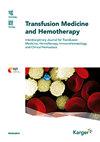In vitro Hemostatic Functions of Cold-Stored Platelets
IF 1.9
4区 医学
Q3 HEMATOLOGY
引用次数: 0
Abstract
Background: Transfusion of platelets is a life-saving medical strategy used worldwide to treat patients with thrombocytopenia as well as platelet function disorders. Summary: Until the end of 1960s, platelets were stored in the cold because of their superior hemostatic functionality. Cold storage of platelets was then abandoned due to better posttransfusion recovery and survival of room temperature (RT)-stored platelets, demonstrated by radioactive labeling studies. Based on these findings, RT became the standard condition to store platelets for clinical applications. Evidence shows that RT storage increases the risk of septic transfusion reactions associated with bacterial contamination. Therefore, the storage time is currently limited to 4–7 days, according to the national guidelines, causing a constant challenge to cover the clinical request. Despite the enormous efforts made to optimize storage conditions of platelets, the quality and efficacy of platelets still decrease during the short storage time at RT. In this context, during the last years, cold storage has seen a renaissance due to the better hemostatic functionality, reduced risk of bacterial contamination, and potentially longer storage time. Key Messages: In this review, we will focus on the impact of cold storage on the in vitro platelet functions as promising alternative storage temperature for future medical applications.冷藏血小板的体外止血功能
背景:输注血小板是全世界用于治疗血小板减少症和血小板功能障碍患者的一种挽救生命的医疗策略。摘要:直到 20 世纪 60 年代末,血小板一直被冷藏储存,因为其具有卓越的止血功能。后来,经放射性标记研究证明,室温(RT)储存的血小板输血后恢复和存活率更高,因此放弃了低温储存血小板。基于这些研究结果,室温成为临床应用中储存血小板的标准条件。有证据表明,室温储存会增加与细菌污染有关的脓毒性输血反应的风险。因此,根据国家指导方针,目前的储存时间仅限于 4-7 天,这给满足临床需求带来了持续挑战。尽管在优化血小板储存条件方面做出了巨大努力,但在 RT 短时间储存期间,血小板的质量和功效仍会下降。在这种情况下,冷藏血小板由于止血功能更好、细菌污染风险更低、储存时间更长等优点,在过去几年中得到了复兴。关键信息:在这篇综述中,我们将重点讨论冷藏对体外血小板功能的影响,冷藏温度是未来医疗应用中很有前景的替代储存温度。
本文章由计算机程序翻译,如有差异,请以英文原文为准。
求助全文
约1分钟内获得全文
求助全文
来源期刊
CiteScore
4.00
自引率
9.10%
发文量
47
审稿时长
6-12 weeks
期刊介绍:
This journal is devoted to all areas of transfusion medicine. These include the quality and security of blood products, therapy with blood components and plasma derivatives, transfusion-related questions in transplantation, stem cell manipulation, therapeutic and diagnostic problems of homeostasis, immuno-hematological investigations, and legal aspects of the production of blood products as well as hemotherapy. Both comprehensive reviews and primary publications that detail the newest work in transfusion medicine and hemotherapy promote the international exchange of knowledge within these disciplines. Consistent with this goal, continuing clinical education is also specifically addressed.

 求助内容:
求助内容: 应助结果提醒方式:
应助结果提醒方式:


